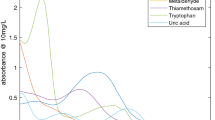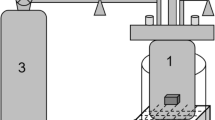Abstract
WHEN petroleum ether extracts of dried leaf material are passed through Tswett adsorption columns composed of magnesia and siliceous earth, the leaf pigments are adsorbed, and colourless solution percolates through the column1. The very first portions of the percolate contain colourless hydrocarbons recoverable in crystalline form. Other colourless substances are slightly adsorbed on the magnesia, and may be recovered from subsequent portions of the percolate. The weakly adsorbed, colourless leaf constituents absorb ultra-violet light, in contrast to the non-adsorbed hydrocarbons which are transparent. Of particular interest, however, are fcwo products which are strongly fluorescent in ultraviolet light. These substances form fluorescent bands or zones on the adsorption columns just below the a-carotene band. The light emitted by the fluorescent bands appears white to the eye, but, in the hand spectroscope, it ranges from the long green to the short red wave-lengths. Crystals, obtained after elution of the fluorescent bands with petroleum ether and ethanol, were strongly fluorescent, being comparable to anthracene and carbazole in this respect. Upon exposure to air the crystals slowly lost their fluorescent properties. Each fluorescent substance, dissolved in cyclohexane, exhibited strong absorption of ultra-violet light, particularly at shorter wavelengths, but no maxima or minima were observed.
This is a preview of subscription content, access via your institution
Access options
Subscribe to this journal
Receive 51 print issues and online access
$199.00 per year
only $3.90 per issue
Buy this article
- Purchase on Springer Link
- Instant access to full article PDF
Prices may be subject to local taxes which are calculated during checkout
Similar content being viewed by others
References
H. H. Strain, J. Biol. Chem., 105, 523 (1934); ibid., 111, 85 (1935).
Author information
Authors and Affiliations
Rights and permissions
About this article
Cite this article
STRAIN, H. Petroleum-soluble Fluorescent Constituents of Leaves. Nature 137, 946–947 (1936). https://doi.org/10.1038/137946b0
Published:
Issue Date:
DOI: https://doi.org/10.1038/137946b0
Comments
By submitting a comment you agree to abide by our Terms and Community Guidelines. If you find something abusive or that does not comply with our terms or guidelines please flag it as inappropriate.



